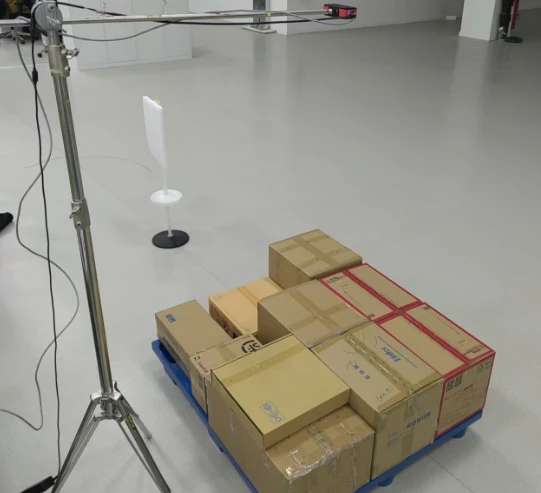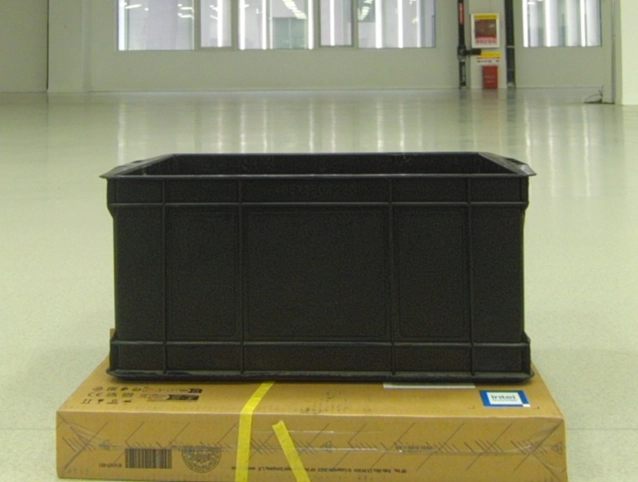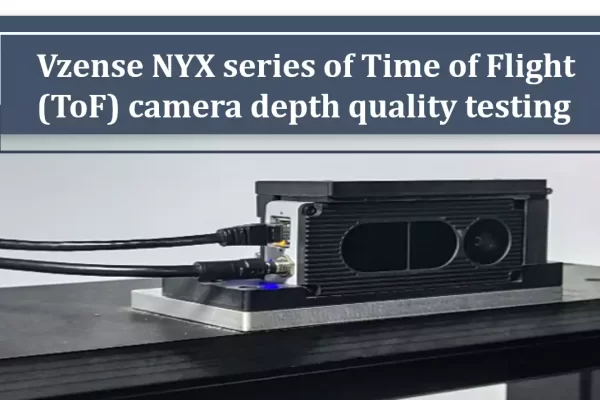With the development of machine vision technology, the use of 3D cameras for object recognition and behavior recognition is becoming increasingly prevalent. Vzense, as one of the leaders in the industrial-grade 3D Time of Flight (ToF) depth camera industry, is a professional provider of 3D ToF products and technical services. The developed products are used in scenarios such as passenger flow statistics and analysis, AGV and AMR pallet recognition and obstacle avoidance, single-piece separation and warehouse slot detection in the logistics field, intelligent depalletizing and palletizing, dynamic picking and sorting, image assistance in the field of industrial automation, safety fences, smart agriculture for fruit and vegetable recognition and picking, etc. This article mainly show the advantages of the DS series and NYX series 3D ToF cameras in different scenarios to facilitate user selection.
Table of Contents
Product introduction
Currently, Vzense is mainly promoting two series of cameras with different working principles, namely the DS series and the NYX series. The parameters are shown in the table below:
| DS series | NYX series | |
| ToF Sensor | RGBD camera developed based on SONY’s CW-iToF(Continuous Wave-indirect Time-of-Flight) chip, IMX570 | RGBD camera developed based on Nuvoton P-iToF(Pulse-indirect Time-of-Flight) chip |
| Laser line | 940nm | 940nm |
| Application scenarios | Indoor and outdoor | Indoor and outdoor |
| ToF resolution | 640×480 | 640×480 |
| ToF frame rate | Max.15fps | Max.30fps |
| ToF FoV(Field of View) | H 67° V 50° | H 70° V 50° |
| RGB resolution | 1600×1200 | 1600×1200 |
| RGB FoV | H 71° V 55° | H 71° V 55° |
| ToF/RGB sensor exposure mode | Global shutter | Global shutter |
| Detection range | 0.15m~5m | 0.3m~4.5m |
DS Series: The DS series currently includes two products, the DS86 and DS87. For detailed information on camera models and functions, please refer to the specifications and user manuals.
NYX Series: The NYX series currently includes two products, the NYX650 and NYX660. For detailed information on camera models and functions, please refer to the specifications and user manuals.
Product comparison
DS series cameras: DS series cameras are designed to industrial-grade standards. Their CW-iToF (Continuous Wave indirect Time of Flight) technology, coupled with global shutter exposure lenses, ensures better data stability, high precision and accuracy, and high resolution. This series are highly resistant to outdoor lighting and is suitable for outdoor scenarios. The bottom of the camera features bidirectional mounting holes, facilitating structural integration and fixation. An optional waterproof design with aviation plugs supports the high protection level of IP67. Some products in the DS series support customized wide-angle lenses.
NYX series cameras: NYX series cameras, based on P-iToF (Pluse indirect Time of Flight) technology, are characterized by high signal-to-noise ratio, strong light resistance, wide dynamic range, preventing range aliasing, and multi-camera coexistence. Their P-iToF technology, combined with global shutter exposure lenses, makes it easier to capture the trajectories of fast-moving objects. They have stronger outdoor light resistance and better adaptability to outdoor scenarios. The cameras are designed to industrial-grade standards, ensuring high reliability and stability. The bottom of the camera features bidirectional mounting holes for easy structural integration and fixation. An optional waterproof design with aviation plugs supports the high protection level of IP67.
You can get a more directviewing understanding of the advantages of different series through the table below:
| DS series | NYX series | |
| Suitable scenarios | Motionless target scenarios | Moving target scenarios |
| ToF frame rate | Max.15fps | Max.30fps |
| Detection range | 0.15m~5m | 0.3m~4.5m |
| Accuracy and precision | Accuracy < 1% Precision < 5‰ | Accuracy < 2% Precision < 1% |
| Multi-machine coexistence | Support | |
| Ambient light adaptability | ⭐⭐⭐⭐ | ⭐⭐⭐⭐⭐ |
Test condition
Based on the characteristics of different series products, multiple scenarios were selected for camera testing. Static scenarios tests included near-range white plaster statue, fruit plates, palletizing and depalletizing. Moving scenarios tests included ball tossing, waving hands, and ball bouncing. Coexistence test of multiple cameras from the same series. Black objects tests included black plastic box, black cylinder. These scenarios are representative and better demonstrate the advantages of each series, making it easier for users to choose suitable products.
Test cameras: The calibrated DS86 and NYX650 cameras were selected for testing. In the DS series, the imaging performance of the DS86 is identical to the DS87, so the performance of the DS86 can represent the DS87. In the NYX series, the imaging performance of the NYX650 is identical to the NYX660, so the performance of the NYX650 can represent the NYX660.
Camera settings: Default settings with a 20-minute camera preheated period.
Static scenarios tests
Indoor-white plaster statue
Ambient light: Indoor ambient light, approximately 200lux.
Distance from camera: 0.8m.
Testing targets: As shown in the image below:

Image comparison: Vzense DS86 vs. Vzense NYX650, the point cloud images are shown as follows:
Indoor-fruits plate
Ambient light: Indoor ambient light, approximately 200lux.
Distance from camera: 1m.
Testing targets: As shown in the image below:

Image comparison: Vzense DS86 vs. Vzense NYX650, the point cloud images are shown as follows:
Indoor-palletizing and depalletizing
Ambient light: Indoor ambient light, approximately 200lux.
Distance from camera: 2.3m.
Testing targets: As shown in the image below:

Image comparison: Vzense DS86 vs. Vzense NYX650, the point cloud images are shown as follows:
Outdoor-white plaster statue
Ambient light: Outdoor ambient light, approximately 90000lux.
Distance from camera: 1m.
Testing targets: As shown in the image below:

Image comparison: Vzense DS86 vs. Vzense NYX650, the point cloud images are shown as follows:
Outdoor-basketball
Ambient light: Outdoor ambient light, approximately 85000lux.
Distance from camera: 1m.
Testing targets: As shown in the image below:

Image comparison: Vzense DS86 vs. Vzense NYX650, the point cloud images are shown as follows:
Outdoor-cardboard box
Ambient light: Outdoor ambient light, approximately 85000lux.
Distance from camera: 1.5m.
Testing targets: As shown in the image below:

Image comparison: Vzense DS86 vs. Vzense NYX650, the point cloud images are shown as follows:
Test description:
Through the comparison of point cloud images in the static test scenarios above, it is evident that, whether indoors or outdoors, the DS86 retains more contour edge details in the point cloud images of objects. The DS86 also provides higher accuracy and precision, better data stability in palletizing and depalletizing.
Therefore, in general static application scenarios, users can prioritize selecting the DS series products. Compared to the NYX series 3D camera based on P-iToF technology, the DS series 3D cameras based on CW-iToF technology offer better data stability, higher accuracy and precision, and complete retention of the details of the measured targets.
Moving scenarios tests
Ball tossing
Ambient light: Indoor ambient light, approximately 200lux.
Distance from camera: 2.5m.
Testing targets: As shown in the image below:

Waving hand
Ambient light: Indoor ambient light, approximately 200lux.
Distance from camera: 0.7m.
Testing targets: As shown in the image below:

Image comparison: As shown in the video below:
Test description:
Through the video comparisons in different scenarios above, it is evident that when capturing moving objects, the NYX650 has better imaging performance, capturing more depth values. On the other hand, the DS86 tends to lose some or even all depth values of fast-moving objects. Additionally, the NYX650 can adjust to a higher frame rate, making the footage appear smoother.
Therefore, when capturing moving scenes, users can prioritize selecting the NYX series products. Compared to the DS series 3D camera based on CW-iToF technology, the NYX series 3D cameras based on P-iToF technology offer better dynamic imaging performance, making them more suitable for capturing the trajectories of moving objects.
Multi-camera coexistence tests
Number of cameras for testing: 6 DS86/NYX650.
Ambient light: Intdoor ambient light, approximately 200lux.
Distance from camera: 1m.
Testing targets: As shown in the image below:

Image comparison: Vzense DS86 vs. Vzense NYX650, as shown in the video below:
Test description:
Through the video comparisons of the different series of cameras mentioned above, it is evident that in scenarios where multiple cameras of the same series are operating together, the NYX650 ToF camera experiences less interference from surrounding cameras and can stably image the target object. In contrast, the DS86 camera experiences more interference from surrounding cameras, resulting in some areas of the target object not being effectively imaged.
Therefore, in application scenarios where multiple cameras need to operate simultaneously, users can prioritize selecting the NYX series products. Compared to the DS series products based on CW-iToF technology, the NYX series cameras based on P-iToF technology can achieve multi-machine coexistence without the need for additional special configurations.
Black objects tests
Black plastic box
Ambient light: Indoor ambient light, approximately 200 lux.
Distance from camera: 1m.
Testing targets: As shown in the image below:

Image comparison: Vzense DS86 vs. Vzense NYX650, the point cloud images are shown as follows:
Black bag
Black cylinder
Ambient light: Indoor ambient light, approximately 200 lux.
Distance from camera: 4.5m.
Testing targets: As shown in the image below:

Image comparison: Vzense DS86 vs. Vzense NYX650, the point cloud images are shown as follows:
sTest description:
Through the comparison of point cloud images in different scenarios above, it is evident that when capturing black objects, the NYX650 has better imaging performance, even at a distance of 3.5 meters, effective imaging can still be achieved with the appropriate exposure time. On the other hand, the DS86 tends to lose some or even all depth values of black objects.
Therefore, when capturing black target scenes, users can prioritize selecting the NYX series products. Compared to the DS series 3D cameras based on CW-iToF technology, the NYX series 3D cameras based on P-iToF technology offer longer expourse time, making them more suitable for capturing the black objects.
Summary
From the comparisons above, it is evident that based on different 3D ToF principles, the DS series cameras using CW-iToF are more suitable for recognizing static scenes, offering better data stability and accuracy or precision, with complete image detail retention. On the other hand, the NYX series cameras using P-iToF provide better dynamic imaging performance, higher frame rates, and are more suitable for capturing the trajectories of moving objects and black objects. They also support multi-machine coexistence with minimal interference between cameras. Users can choose the product that best suits their needs based on the characteristics of different series and the requirements of their actual scenarios.












